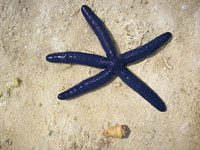

 | |||||||||||||||||||
|
|
Journals 2008/2009Zamaria Rocio
September 8, 2008 I love getting up in the morning because everyday is unique here on the island. Each low tide exposes me to creatures and plants I had never seen before. When I reef walk, I could be fifty yards out from the shoreline and the water would still be below my knees. What was so spectacular was the vividness of the living thing I was seeing under water. Even though my digital camera was not waterproof, I could take pictures above the water and they would come out very clear.
More common were the sea cucumbers, also echinoderms. These creatures would slowly move, making them excellent candidates for a photograph. They were described to me as vacuum cleaners because they would pick up sand and digest the nutrients that were on its surface. I was also told that some sea cucumber species are gathered and dried for sale in Asian countries.
Whenever I went reef walking, I saw numerous clams that had colorful mantles. Their mantle has light and pressure spots that are sensitive these help the clam to close quickly if it was disturbed. In their mantle are zooxanthellae, which are microscopic algal cells, which help to produce food for them.
Walking along one stretch of beach I found about a hundred giant chitons exposed by low tide on rubble. These are mollusks with a strong muscular foot. These are about 10 cm long. You could count the eight hard plates on their backs. Algae were growing on their backs. Everywhere I stepped was wonderful photo opportunities.
|
||||||||||||||||||




